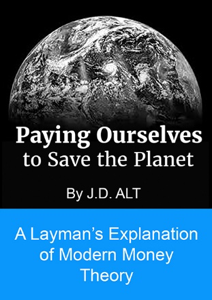By J.D. ALT The last two and a half months I’ve been at work on a new book. As it evolved, I found I was approaching MMT from a new direction—one which made an explanation of MMT much less counter-intuitive and, perhaps, less controversial. The approach is relatively simple and straight-forward: follow what I began calling “standard money theory” step by step until one reaches a perspective that has, almost seamlessly, become “modern money theory.” The book first considers why the “standard theory” we insist on applying to the world is incapable of addressing the climate-change crisis. (The exact same arguments could now be applied to confronting and mitigating the pandemic crisis!) Second, it explains how a simple shift in perspective transforms the standard money theory into
Topics:
J.D. Alt considers the following as important: J. D. Alt, MMT, Modern Monetary Theory
This could be interesting, too:
Mike Norman writes Jared Bernstein, total idiot. You have to see this to believe it.
Steve Roth writes MMT and the Wealth of Nations, Revisited
Matias Vernengo writes On central bank independence, and Brazilian monetary policy
Michael Hudson writes International Trade and MMT with Keen, Hudson
By J.D. ALT
The last two and a half months I’ve been at work on a new book. As it evolved, I found I was approaching MMT from a new direction—one which made an explanation of MMT much less counter-intuitive and, perhaps, less controversial. The approach is relatively simple and straight-forward: follow what I began calling “standard money theory” step by step until one reaches a perspective that has, almost seamlessly, become “modern money theory.”
The book first considers why the “standard theory” we insist on applying to the world is incapable of addressing the climate-change crisis. (The exact same arguments could now be applied to confronting and mitigating the pandemic crisis!) Second, it explains how a simple shift in perspective transforms the standard money theory into modern money theory (MMT)—which CAN confront the crisis.

The explanation of MMT is given twice: first in a narrative that explains the Reserve/bank-dollar system that both private and public enterprise use to buy goods and services; the second rendering of the explanation is more concise and is illustrated with diagrams. This diagrammatic explanation is completely different than what was presented a few years ago in the ebook “Diagrams & Dollars.”
This new book, for me, is a definitive “layman’s explanation” of modern money theory—and why it is so important, at this moment in time, for MMT to be widely understood by the general public. The new diagrams lend themselves to seminar presentations, and to that end I will be making them freely available for download on my website www.jdalt.com. It is my hope they’ll be used by knowledgeable laymen to get serious MMT conversations going in local communities around the country. That’s a big hope, I know, but the times call for big hopes.
The book is now available at Amazon.
